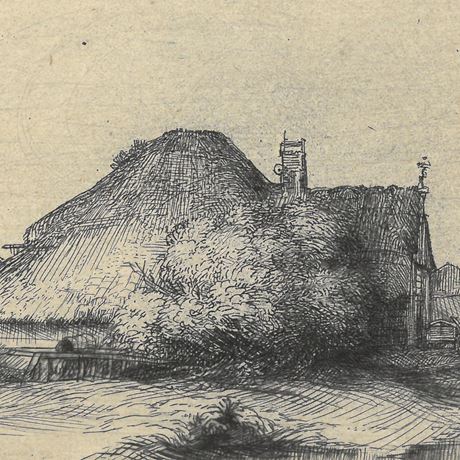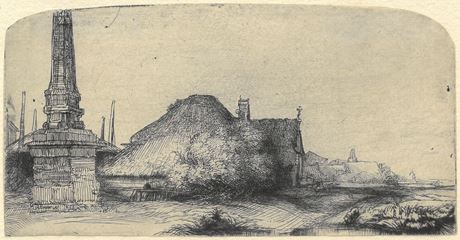REMBRANDT HARMENSZOON VAN RIJN
Cottage and Boundary Post on the Spaarndammerdijk
Etching and drypoint. 8,4 x 16,3 cm
Bartsch 227; Rovinski, Seidlitz and White-Boon 227/II; Hind 243/II; Biörklund-Barnard 50-3/II; New Hollstein 249/II
Extremely fine early impression showing unusual rich burr especially on the bushes and grasses in the foreground.
The intense platetone, the distinctive marks of sulphurtint and the delicate ellipsoid wiping marks in the sky are surplus indications of the superb quality of this impression.
Cut close – but without any loss – on the platemark following its rounded shape on top.
Such excellent impressions with delicately balanced effects of light and shadows and with ‘soft’ gradual transitions between fore- and background as especially intended by the artist are extremely rare.
According to Lugt the location can be identified with the Mijl-en banpaal (mile- and bordermarker) of Spieringshorn near Halfweg (halfway between Amsterdam and Haarlem).
The etching with drypoint was created in two states in about 1650. In the first state the landscape was all but complete, but the burr on and around the farmhouse behind the boundary post was so heavy that it caused a spotty effect and effectively obscured the lightly indicated building in the distance. In order to achieve a more gradual transition between foreground and background and so improve the effect of perspective in the scene, Rembrandt removed part of the burr and shaded the houses in the background, while he also added lines to darken the land in front of it, the base of the boundary stone and the water in the foreground where a dog is drinking. Grain with fine, loop-shaped scratches in it was already present above the farmhouse in the first state. This can be seen more clearly in early impressions of the second state. (E. Hinterding)








